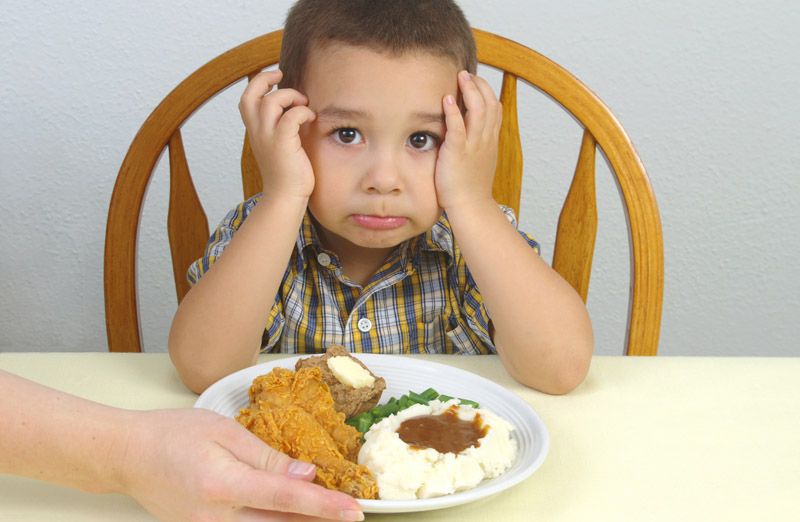1. Don’t spoil your child by giving in and offering their favorite food all the time
If a child refuses food, parents get scared that he or she will stay hungry. However, if this happens you should definitely avoid giving your child his or her favorite food immediately. This is because your child will learn to manipulate you into getting what they want every time, and the food the child wants probably isn’t healthy or rich in essential nutrients. Instead, you can give the child a smaller portion or a healthy snack like some fruit. That way they will not have an empty belly and they will be more eager to eat when it’s time for the next meal.
2. Have your main meals at a set time each day
Three main meals a day—breakfast, lunch, and dinner—served at about the same time every day is the key. You can also give your child one or two healthy snacks a day, but not more than that. If a child eats snacks all day, especially before meals, she won’t be hungry and probably will refuse to eat. Many kids would rather have a pack of chips than a balanced meal. If you have meals at a set time of day, the child will eventually get hungry right before the meal, which reduces the chances of him or her refusing to eat. Always keep at least two hours between snacks and meals.
3. Feed your kids the same thing you eat
Be honest, even you would probably rather eat pizza than something healthy, but if you eat a burger and feed your kids vegetables, they will protest and want the burger, too. Kids look up to you. So if you want to teach your child to eat a variety of food, you should set the example and do it yourself first. And if you are all eating the same thing, your child won’t have a reason to complain.
4. Have several different types of food at every meal
We all know that a balanced meal has many health benefits. Your child needs over 40 different nutrients every day for good health, and, of course, you cannot find all of that in a single type of food. There are five food groups important for child’s nutrition—dairy, veggies, fruits, grain foods, and meat. All of this combined gives your child enough vitamins, minerals, and fiber. Besides, when you serve different types of food every time, even if your child refuses to eat some of them, he will still get enough nutrients for the day.
5. Take away distractions at the dinner table
Your child should know that when it’s meal time it’s time to eat. That means no TV, no games, and no toys or other distractions at the dinner table! If you let your child play while eating she will learn that the dinner table is a playground and get too distracted to eat. Most kids would rather play than eat, especially if it doesn’t like the food you served. So, save games and toys for the playground and the food for the dinner table.
6. Teach your kids proper table manners
Let’s face it—most kids are not neat while eating. They spit and burp and eat with their hands. In order to teach you child proper table manners, what you have to do first is set the example. Don’t let your kid see you eating with your hands, or sitting on the couch. Children imitate what they see. Manners start at the moment you call your children for dinner. One of the first things you have to teach your kids is that they have to wash their hands before meal, find their spot at the table, and sit until everyone is done. Also, try eating with the whole family as much as possible . And, of course, don’t forget to praise your child. When they do something right tell them, “Good job!”
7. Never try to bribe your child with sweets
Unlike just giving in and letting them eat what they want, some parents try to bribe their kids with the promise of dessert. If you try to bribe a child with sweets she will get used to it and will ask for sweets every time. The child will then associate sweets with some kind of reward and vegetables will become even less appealing compared to sweets. This fosters bad habits and can lead to eating disorders later in life, e.g., eating lots of sweets when you feel bad, or as a reward after a hard day at school or work. Of course, it is alright to give your kids sweets from time to time. If the child is completely restricted from having snacks or sweets, the desire for them will increase, and the probability of a child overeating when they do get the chance to eat sweets is high. Just don’t make them a bargain chip or special reward. You can reward them with fun play time or by teaching them a cool skill.
8. Make sure they eat at least one bite of everything on the plate
Many parents are already familiar with the one-bite rule. It states that the child must eat at least one bite of everything on the plate—it’s as simple as that. The child doesn’t have to like it, they just have to take one bite of each food. The most important thing about this rule is that a child doesn’t have to eat more if they don’t like it, so don’t force your kid to eat more. One bite is one bite. Eventually, the child will probably get used to many different types of food and with some luck, he will eat more than just that one bite.
9. Let them try out different recipes with same food
Picky eaters refuse eating many types of food, but in most cases it’s vegetables. You can try to make your child eat something they don’t like by simply changing it a bit. If the kid won’t eat tomatoes, try making a nice tomato sauce, or if she doesn’t like boiled eggs, try making an omelet. For every food your kid hates, you can find a recipe for making it another way, so that your kid doesn’t even know what’s really in the meal.
10. Keep offering your kid different foods he or she gets used to them
If your child refuses to eat something, don’t write it off immediately. Just switch to something else. Children will usually need at least 10-15 tries to get used to a new taste. You will just have to be persistent. When a kid doesn’t like the new food the first time, try it again. Kids often smell or touch new food first, so just be patient. There are some easy shortcuts for this problem, like serving new food with your child’s favorite food or the one bite rule mentioned previously.
11. Chop up veggies to into small chunks and put them in every dish
Lots of kids hate vegetables. One of the most difficult things is to get your child to eat vegetables, especially if he or she is a picky eater. If you chop up veggies into very small chunks you can put them in every meal without the child even noticing. Be sure to clean the veggies properly first—you don’t want your child to start associating vegetables with stomach problems. Kids often use their eyes to gauge if something seems appealing, and if they see vegetables on the table they will refuse to eat them. You can also cut the food into various shapes with cookie cutters. This way you can get your child to like fruits and vegetables without them knowing.
12. Spices and sauces are a great way to help the child associate new foods with a familiar taste
If it’s hard to get your child to try new food, you should definitely try this: Is there a spice or sauce your child enjoys? Just put that in the food you are trying to get your kid to eat, and you will get new food but with an old familiar taste. Try putting less of it in the food every time until the child gets used to a new taste. That is a great way to help your child gradually warm up to new food and new tastes. Proper nutrition is vital for a child’s health. Children have their own unique needs regarding food because they are still growing, and it’s up to their parents to fulfill those needs. Always remember that the key for healthy eating is to enjoy a variety of foods. That’s the only way your body can receive all the nutrients, vitamins, and minerals it needs to function properly. And don’t forget to celebrate small victories—if your child accepts even one type of new food, it is a good start!











